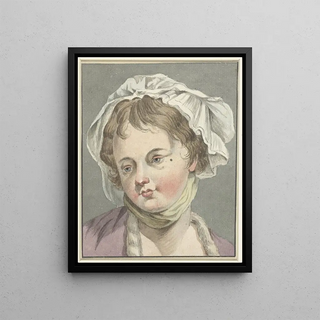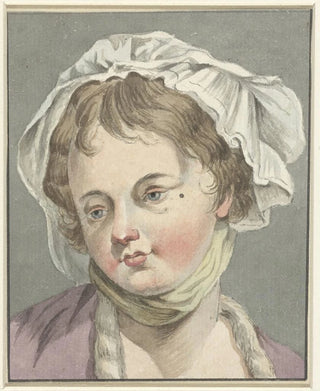Art print | Girl's Head - Jean-Baptiste Greuze Source: Reproduction | Tête de fille - Jean-Baptiste Greuze


View from behind

Frame (optional)
Jean-Baptiste Greuze’s “Head of a Girl” is a work that transcends mere portraiture to become a true ode to youth and female beauty. Captured with extraordinary delicacy, this painting draws us into a universe where emotions are palpable and every detail tells a story. The artist, renowned for his talent in capturing the human soul, manages here to create an immediate connection between the viewer and the model. The softness of the girl’s features, illuminated by subtle light, evokes a tenderness that resonates through the centuries, making this piece a must-have in art history.
Style and uniqueness of the work
Greuze’s style is distinguished by its naturalistic approach and keen sense of realism. In the “Head of a Girl,” one perceives an exceptional mastery of nuances and shadows, which give the girl’s skin an almost lifelike glow. Every brushstroke seems to have been applied with meticulous attention, revealing not only the physical beauty of the subject but also a rare emotional depth. The composition, focused on the face, allows the viewer to concentrate on the expressive eyes and the slight smile of the girl, suggesting an inner thought or a whispering secret. This artistic choice, far from being trivial, invites contemplation and reflection, rendering the work timeless.
The artist and his influence
Jean-Baptiste Greuze, an emblematic figure of the 18th century, knew how to mark his era with his ability to translate human emotions onto canvas. Raised in a context where rococo and neoclassicism coexisted, he managed to break free from conventions to develop a distinctive style, centered on the expression of sensitivity. His works, often imbued with morality, testify to a concern for the human condition and social relations. Greuze influenced many artists, not only through his technique but also through his narrative approach, which paved the way for later movements. His ability to capture the very essence of the human being, through vibrant portraits, makes him an essential figure in art history.
An exceptional wall decoration signed

Matte finish

View from behind

Frame (optional)
Jean-Baptiste Greuze’s “Head of a Girl” is a work that transcends mere portraiture to become a true ode to youth and female beauty. Captured with extraordinary delicacy, this painting draws us into a universe where emotions are palpable and every detail tells a story. The artist, renowned for his talent in capturing the human soul, manages here to create an immediate connection between the viewer and the model. The softness of the girl’s features, illuminated by subtle light, evokes a tenderness that resonates through the centuries, making this piece a must-have in art history.
Style and uniqueness of the work
Greuze’s style is distinguished by its naturalistic approach and keen sense of realism. In the “Head of a Girl,” one perceives an exceptional mastery of nuances and shadows, which give the girl’s skin an almost lifelike glow. Every brushstroke seems to have been applied with meticulous attention, revealing not only the physical beauty of the subject but also a rare emotional depth. The composition, focused on the face, allows the viewer to concentrate on the expressive eyes and the slight smile of the girl, suggesting an inner thought or a whispering secret. This artistic choice, far from being trivial, invites contemplation and reflection, rendering the work timeless.
The artist and his influence
Jean-Baptiste Greuze, an emblematic figure of the 18th century, knew how to mark his era with his ability to translate human emotions onto canvas. Raised in a context where rococo and neoclassicism coexisted, he managed to break free from conventions to develop a distinctive style, centered on the expression of sensitivity. His works, often imbued with morality, testify to a concern for the human condition and social relations. Greuze influenced many artists, not only through his technique but also through his narrative approach, which paved the way for later movements. His ability to capture the very essence of the human being, through vibrant portraits, makes him an essential figure in art history.
An exceptional wall decoration signed






